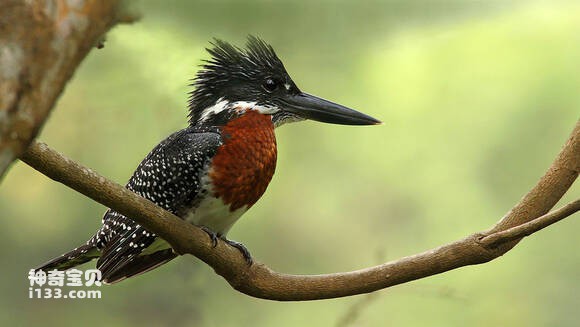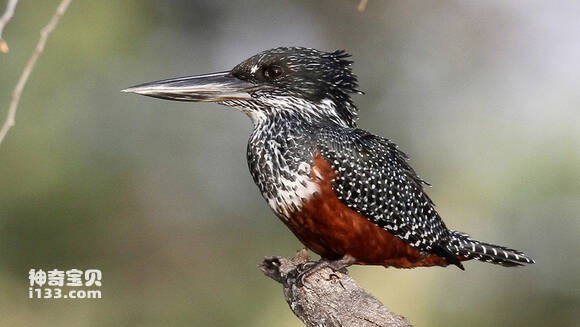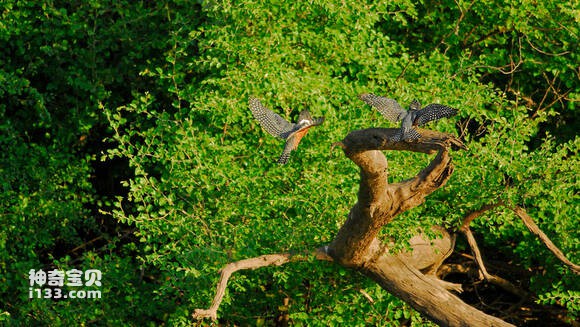Megaceryle maxima
IUCN
LCBasic Information
Scientific classification
- name:Megaceryle maxima
- Scientific Name:Megaceryle maxima,Giant Kingfisher
- Outline:Climbing birds
- Family:
Vital signs
- length:42-48cm
- Weight:255-426g
- lifetime:No textual research information is available
Feature
It is the largest kingfisher in Africa
Distribution and Habitat
Found in central and southern Africa, Including Angola (Angola), Benin, Botswana, Burkina Faso, Burundi, Cameroon, Central African Republic, Chad, Congo, Democratic Republic of the Congo, Cote d 'Ivoire, Equatorial Guinea, Eritrea, Ethiopia, Gabon, Gambia, Ghana, Guinea, Guinea-Bissau, Kenya, Lesotho, Liberia, Malawi, Mali, Mauritania, Mozambique, Namibia, Niger, Nigeria, Rwanda, Senegal, Sierra Leone, South Africa, South Sudan, Sudan, Eswatini, United Republic of Tanzania, Togo, Uganda, Zambia, Zimbabwe.
It mainly lives in forest streams, plain valleys, reservoirs, ponds, and even the bank of paddy fields.
Appearance
The Big fish dog is a large water bird. Body length 42-48 cm, weight 255-426 grams. The head has a crest, and the black upper body has many fine white ellipses or other large spots of shape. The female has a maroon belly and a black breast with white spots. The male bird has dark spots on the side, a chestnut-colored chest, and a white belly with black spots. White under mouth, pillow, back neck; The back, waist, and lower tail are covered with gray black feathers, with many white spots on each feather. The wings are black, the primary flight feathers have many less round white spots, and the secondary flight feathers have many neat white stripes. Chin and throat are white, and there is a thick white stripe on the neck extending to the front chest. Iris brown; Mouth black, upper mouth base and apex light greenish-brown; The feet are brown.
The beak is large, long and pointed, like a spear, with a rounded crest; Nasal sulci was significant; The wingtip of the first primary feather is
Details
Megaceryle maxima, the foreign name Giant Kingfisher, has two subspecies, one is the named subspecies (M. m. maxima), distributed in the open country, and the other is the rainforest subspecies (M. m. gigantea), distributed in the rain forest. The varieties in the rainforest zone are slightly darker, with fewer spots on the upper half and more patches on the lower half. The two species interbred at the edge of the forest.

Big fish dogs constantly chirp as they fly, especially when they fall quickly into the water to hunt. Sexual loneliness, usually live alone near the water, including rivers, estuaries, beaches and sewage ponds on the branches or rocks. Common in villages along water furrows in the arid plains and irrigated plateaus of south and southern Africa to hunt for food in the same way as kingfishers, often on the surface or diving to hunt; Sometimes they can even disappear completely under water; Sometimes they flap their wings and stop flying in the air about 3-10 meters from the water, as if they were hanging on the water, and when they see the bait, they immediately dive into the water to hunt.

The food of the dog is mainly small fish, and eats crustaceans and a variety of aquatic insects and their larvae, but also pecks at small frogs and a small number of aquatic plants. Completely carnivorous, the food varies from region to region: in Liberia and South Africa, freshwater crabs are mainly consumed, and in Zaire, fish. Small crabs can be swallowed whole, and those crustaceans with 35-45 mm dorsal armor shred before swallowing. In order to supplement their nutrition, they also hunt different 3-7 cm long mosquito fish, small freshwater fish, frogs, toads, centipedes and small reptiles. Subadult birds feed mainly on fish: they prey on fish up to 18 cm long.

Big fish dog single match, breeding period in August to January every year. On the banks of rivers and streams, tunnels are dug with mouths for nests, which are 11 centimeters high, 15 centimeters wide and 2 meters deep. The female incubates her eggs alone. The nest has no bedding. Each brood lays 2-3 eggs, oval, solid, white smooth with small spots. Incubation period is 22-24 days. Young are late creatures.
Listed in the International Union for Conservation of Nature Red List of Threatened Species (IUCN) for 2016 ver 3.1 - Not Threatened (LC).
Protect wild animals and eliminate wild meat.
Maintaining ecological balance is everyone's responsibility!








